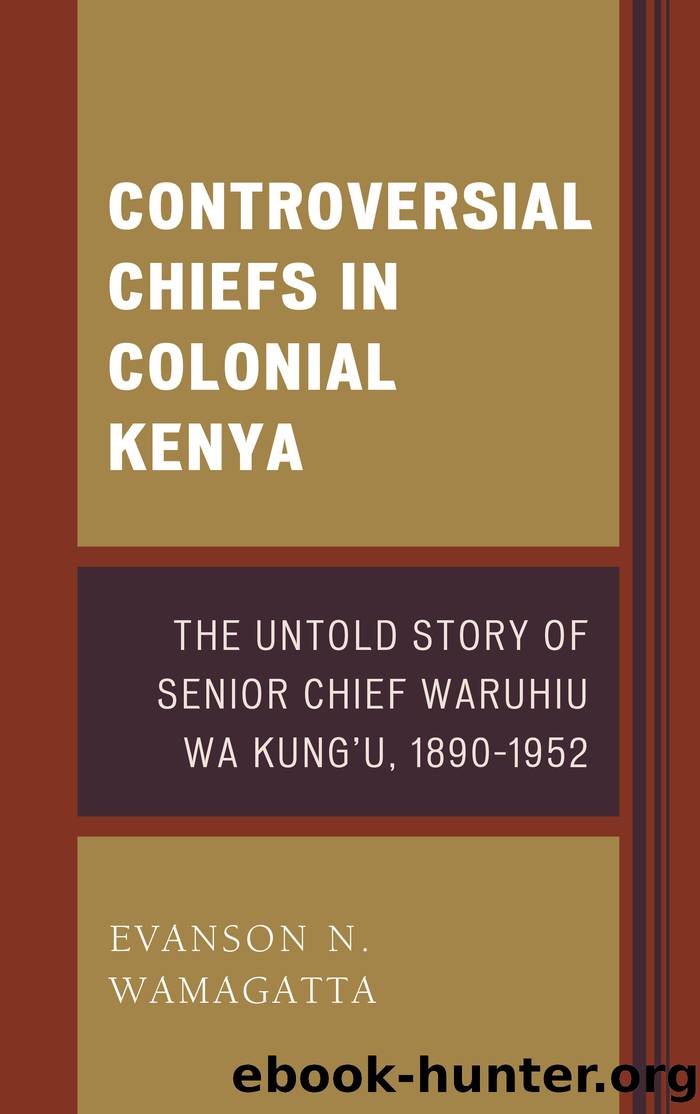Controversial Chiefs in Colonial Kenya by Wamagatta Evanson N.;

Author:Wamagatta, Evanson N.;
Language: eng
Format: epub
Tags: undefined
Publisher: Lexington Books
Published: 2012-08-15T00:00:00+00:00
Other Matters of Interest
Waruhiu, being agriculturally minded, was an ardent supporter of agricultural development in the district. Beginning in 1938, he relentlessly exhorted the LNC to initiate a dipping program in the district. In December 1944, he reiterated that there was a great need for dips since the buying of grade cattle was a very expensive undertaking. He cited the case of Crispus Mwaniki who had lost forty head of grade cattle to tick-borne diseases. He wanted the LNC to construct at least one dip in each division.[99]
In July 1945, Waruhiu was in a LNC deputation that visited Nyeri to appraise the dipping scheme there. The delegation was impressed and it wanted a similar scheme to be introduced in Kiambu.[100] In February of the following year, the DC informed the LNC the conditions under which it would be allowed to construct dips. A dipping fee of one shilling per head of cattle per annum would be imposed to meet the recurrent operating costs of the dips. Secondly, it would be mandatory for every stockowner to present his cattle for dipping once each week. Thirdly, cattle culling would be introduced to get rid of âa number of uneconomical and useless beasts.â[101] But before the LNC could make a decision, another delegation visited Nyeri in July 1946 to assess their dipping scheme once again. In the final analysis, the LNC rejected the introduction of dipping because it objected to compulsory dipping, culling and dipping fee.[102]
Waruhiu, who favored the introduction of dipping in the district, asked the DC whether the LNC would construct dips for locations which agreed to abide by the dipping regulations. The DC responded in the affirmative. Maguguâs location applied for dips first followed by Waruhiuâs location. Maguguâs dips were built in 1948 at Marige, Gathugu, and Gathiruini and they became operational in January 1951.[103] Although the LNC agreed in April 1949 to construct dips in Waruhiuâs location, it procrastinated. In early 1951, Waruhiu pleaded with the LNC to construct the dips since his people had been waiting for a long time. But the dips were never constructed because the government changed its policy and deemed the dips were a matter for local efforts rather than a burden for the LNC.[104]
Waruhiu also fought for Kikuyu farmers to be given loans. In 1931, the LNC Agricultural Sub-Committee, of which he was a member, formulated a resolution which was adopted by the LNC that called on the government to set aside money to be loaned for developing their holdings. When the government rejected the proposal, Waruhiu demanded to know how else they could borrow money. The DC informed him that the banks could not lend them money since they had nothing to mortgage as they had no title to their land.[105]
Although the credit issue was revived by Mathu in February 1944, the DC reiterated that they could not be loaned money because they did not have adequate security. Considerable discussions followed and Waruhiu enquired whether the policy of not loaning money to Africans was âa permanent and irrevocable Government edict.
Download
This site does not store any files on its server. We only index and link to content provided by other sites. Please contact the content providers to delete copyright contents if any and email us, we'll remove relevant links or contents immediately.
Goodbye Paradise(2966)
Men at Arms by Terry Pratchett(2406)
Tobruk by Peter Fitzsimons(2062)
Pirate Alley by Terry McKnight(1909)
Arabs by Eugene Rogan(1836)
Borders by unknow(1787)
Belonging by Unknown(1467)
The Biafra Story by Frederick Forsyth(1324)
It's Our Turn to Eat by Michela Wrong(1303)
Botswana--Culture Smart! by Michael Main(1238)
A Winter in Arabia by Freya Stark(1225)
Gandhi by Ramachandra Guha(1196)
Coffee: From Bean to Barista by Robert W. Thurston(1181)
Livingstone by Tim Jeal(1152)
The Falls by Unknown(1142)
The Source by James A. Michener(1135)
The Shield and The Sword by Ernle Bradford(1101)
Egyptian Mythology A Fascinating Guide to Understanding the Gods, Goddesses, Monsters, and Mortals (Greek Mythology - Norse Mythology - Egyptian Mythology) by Matt Clayton(1088)
Africa: Altered States, Ordinary Miracles by Richard Dowden(1078)
